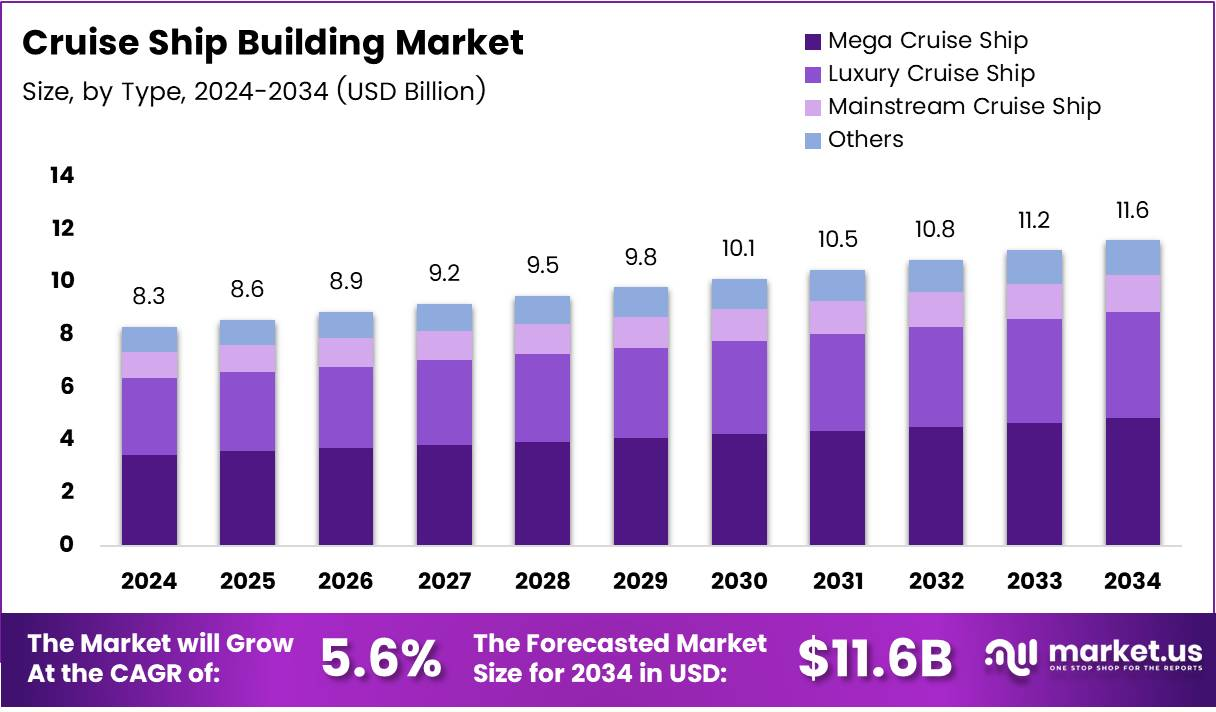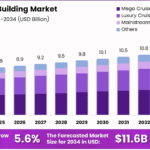Introduction
Maritime leisure, once the realm of aristocrats and oceanic adventurers, has transformed into a billion-dollar industry. At the epicenter of this transformation lies the cruise ship building market a behemoth that fuses luxury, engineering prowess, and sustainability. The modern cruise vessel is no longer just a floating hotel; it is a microcosm of experiences, powered by technological wizardry and evolving consumer expectations. As global affluence grows and the appetite for immersive travel deepens, the cruise ship building market stands poised for a new era of opulent innovation.
For more info please visit: https://market.us/report/cruise-ship-building-market/
Market Overview
In recent years, the global cruise ship building market has surged, projected to surpass USD 32 billion by 2030, underpinned by a compound annual growth rate that reflects both robust demand and rising shipyard capacities. Europe, particularly Germany, Italy, and Finland, remains the heart of cruise ship manufacturing, home to industry titans such as Meyer Werft, Fincantieri, and Chantiers de l’Atlantique. Meanwhile, Asia-Pacific led by China’s aggressive shipbuilding strategy is rapidly gaining traction, supported by government investments and expanding technical expertise.
North America continues to anchor demand, propelled by cruise liners headquartered in Miami and Vancouver. The consolidation of global players, such as Carnival Corporation, Royal Caribbean Group, and MSC Cruises, drives an ecosystem where scale, brand differentiation, and vertical integration define market power.
Technological Innovations Reshaping Cruise Ship Design
Innovation is rewriting the blueprint of shipbuilding. Environmental legislation and carbon accountability have catalyzed the adoption of liquefied natural gas (LNG) propulsion, hybrid systems, and even early-stage hydrogen cell exploration. These advancements, once niche, are becoming mainstream requisites in new-build contracts.
Beyond propulsion, ships now boast AI-enabled infrastructure from predictive maintenance to smart HVAC systems that optimize energy usage and passenger comfort. Interior spaces adapt dynamically, guided by real-time occupancy data. Furthermore, modular construction methods have revolutionized production timelines, enabling simultaneous fabrication of ship sections across geographies, then assembled with surgical precision in dry docks.
Consumer Preferences and Experience-Driven Design
Today’s travelers are discerning, their preferences molded by Instagram, climate awareness, and a desire for exclusivity. Cruise operators are responding with boutique vessels, often accommodating fewer than 200 passengers, yet outfitted with Michelin-starred dining, polar expedition capabilities, and immersive cultural programming.
Themed cruises ranging from culinary explorations to space-themed journeys have spurred demand for custom ship interiors. Additionally, wellness-focused amenities, such as floating spas, meditation pods, and biophilic architecture, are no longer optional but expected.
Eco-tourism is gaining momentum, with consumers favoring ships that sail into protected zones without ecological intrusion, leveraging dynamic positioning systems instead of traditional anchors and minimizing underwater noise pollution.
Economic and Regulatory Drivers
Governments, particularly in Europe and Asia, are infusing billions into their shipbuilding sectors through tax incentives, maritime funds, and innovation grants. However, these benefits are juxtaposed against tightening IMO regulations on emissions, waste management, and onboard fuel usage.
Raw material volatility, notably in steel and advanced composites, has injected uncertainty into cost projections. The pandemic-induced supply chain disarray still casts a lingering shadow, complicating logistics for specialized components like azipods and marine-grade HVAC units.
Labor dynamics also shift, with a growing shortage of skilled shipbuilders and marine engineers. Nations are ramping up vocational training and re-skilling programs to ensure continuity of expertise, especially as digital shipbuilding platforms demand hybrid skill sets combining craftsmanship and software fluency.
Challenges and Market Constraints
The industry faces an intricate web of constraints. Rising inflation impacts ship construction budgets, while stringent financing terms from banks wary of long payback periods compound capital acquisition. The environmental lobby also exerts considerable influence, pressing cruise lines to achieve net-zero emissions and pushing builders to integrate cutting-edge clean technologies at scale.
Port infrastructure remains an Achilles’ heel. Many emerging cruise destinations lack the facilities to berth large vessels or provide adequate refueling, provisioning, and waste management services. This logistical mismatch limits itinerary expansion and passenger volume growth in high-potential regions.
For more info please visit: https://market.us/report/cruise-ship-building-market/
Future Outlook and Strategic Opportunities
Despite challenges, the future remains luminous. Rising middle-class populations in India, Southeast Asia, and Latin America are creating untapped demand for cruise travel, leading to increased orders for smaller, regionally adapted ships.
Digital twin technology is revolutionizing design and maintenance. These virtual replicas enable simulation of stress conditions, passenger flows, and energy usage empowering builders to optimize before steel is cut. Furthermore, co-innovation models, where shipyards, cruise operators, and tech firms collaborate from ideation to launch, are fostering faster, more aligned development cycles.
Strategic alliances such as shipyard-tech integrations and joint ventures are unlocking new capabilities and market entries, ensuring that the cruise ship building industry continues to evolve not only in size but in sophistication.
Conclusion
The cruise ship building market is navigating a sea of transformation, where traditional craftsmanship meets futuristic innovation. As environmental mandates tighten and consumer tastes diversify, shipbuilders must chart a strategic course that balances cost-efficiency, sustainability, and experiential opulence. Amid global shifts in economic power and technological disruption, the industry’s next chapter is one of bold reinvention and boundless opportunity.






